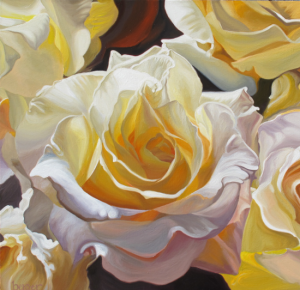Dear Artist,
Just below where we live in Crescent Beach, B. C., there’s a fine public marina. I’ve been wandering down there for years. Some of the locals occasionally drop by to see what I’m up to. One day an unknown passerby paused to ask me if this were my day off work.

Robert Genn at the Marina, 2010,
painting in his 1926 Austin 7 Chummy
while Dorothy the Airedale keeps watch.
More recently, a more evolved watcher asked, “What is it with you guys about boats propped up on land?” I told him that down here they keep moving things around, especially during the fall and spring, and different relationships are often seen, so the light and shade are a challenge.
While this system might not float everyone’s boat, I find it best to rough in general shapes and patterns early on, while keeping only a partial eye on the eventual lay of the light. In other words, the strongest light areas go in at about the half-way stage of the painting. Adjusting the right tones for light and shade can be tricky and if you commit yourself too early, things can get pasty or, worse still, murky.
I look for light patterns that are of unusual shapes, big and small, with abstract potential. Making up this pattern is important, but it’s also an opportunity to change a few of the local, impinging colours. Having brushed paint on our own boats a few times, I can tell you it’s a darn sight easier to change the colour of a boat on canvas. The bottom coats in my subjects this day were green. Lead oxide seemed a better choice. Better for barnacles, too.
It’s also a good idea to overdazzle your lights, even softening the edges of the bright parts so the light glows. Leave the details, complexities and nuances to the shadows. The rule here is “Light burns out detail.”
Finessing a more or less correct but often subtle relationship between light and shade is one of the tough orders. A valuable idea is “look three times, think twice, paint once.” The acrylic medium permits endless corrections, rethinks and resurrections. I figure if you can get the tonal and colour relationships within ten percent of reality you’re doing well. It’s all an illusion, but a fresh, confident-looking light-and-shade gives joy to your sortie.
Best regards,
Robert
PS: “Of the original phenomena, light is the most enthralling.” (Leonardo da Vinci)
Esoterica: If you want to better understand the nuances of light and shade, study the work of Joaquin Sorolla. “Let there be no mincing of comparisons,” said James G. Huneker, “not Turner, not Monet, painted so directly blinding shafts of sunlight as has this Spaniard.” Down by the boats and beaches of Andalusia, working mainly in the Magic Hour when lights were warm and shadows were cool, Sorolla paid close attention to reflected light bouncing around in the shadows. How does one achieve this deadly eye? Practicar. (Practice)
This letter was originally published as “Light and shade” on November 2, 2010.
The exhibition Robert Genn: A Lifetime of Painting continues at Madrona Gallery in Victoria, B.C., Canada until February 2, 2019.
“Nature, the sun itself, produces color effects… instantaneously. The impression of these evanescent visions is what we make desperate attempts to catch and fix by any means at hand. At such moments I am unconscious of materials, of style, of rules, of everything that intervenes between my perception and the object or idea perceived.” (Joaquin Sorolla)
Featured Workshop
Join Travel Journal Sketch Artist Darsie Beck at Port Townsend School of the Arts and learn how to create your own travel journal. Discover how to create memory enhancing images. Experience the ease of working with watercolor pencils, water brush and pens to enrich your journal entries.
This workshop provides an introduction to the process of creating a travel sketch journal from page design, material demonstration and field sketching in and around historic Fort Worden and Port Townsend, Washington.
Register at https://ptschoolofthearts.org/ for either March or April workshops.
Featured Artist
Gardens are my enduring inspiration, and getting to the heart of the flower, my passion.









6 Comments
Beautiful paintings and re-post and quotes by Sorolla, too. Thanks
Thanks for such an informative and educational letter. Never to late to learn something new.
Regards from sunny South Africa
Hetta Ludik
I’m replying from my casa in San Miguel de Allende Mexico where the morning sun is doing it’s daily thing – displaying bright, clear light and dramatic shadows. The lesson here is so vital to the representational artist regardless of which medium they are using. Getting the values right is paramount.
God. I LOVED SAN Miguel. You lucky man. Saying hello from Victoria BC.
Wonderful picture of Robert, Dorothy and that really cool car.
Since you featured the exact painting he was making there is an added feeling of connection. This letter is very helpful, some excellent nuts and bolts of how to. Fun to see a snippet of how his style changed and what was constant in those 23 years.
I wish I could make the it to Victoria before the show closes, not in the cards. But I will always greatly appreciate the visit to the White Rock Gallery and seeing some of Roberts paintings.
Celebrating the capture of light, bright wishes to you and all.
Thank you Sara & Robert
Dara I still feel a tug in my heart when I read Roberts letters , but reading makes me feel he is still with us Love his work